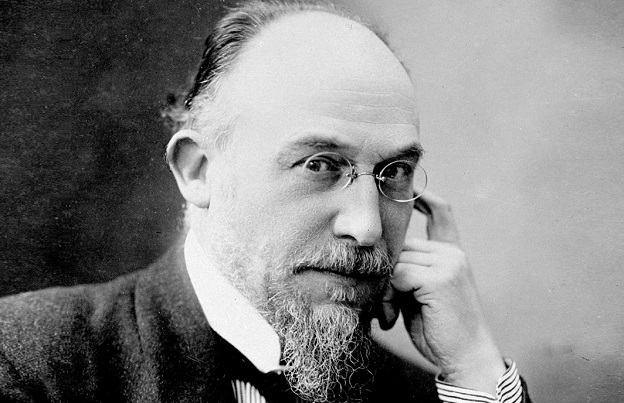Erik Satie was born in Honfleur, 17 May 1866, next year we will remember the 155 years since his birth. Son of a Scottish mother, he studied at the Paris Conservatoire, where his music was considered insignificant and laborious and considered untalented, the laziest student in the conservatoire. Described by Rollo Myers as “hermit, saint, philosopher, wit, bouffon, Socratic ironist, an enemy of convention, champion of youth and fearless explorer along new and untried paths in art”, he is now the person in the world of music most closely related to Surrealism.
At the end of the 19th century, in Montmartre, a young Erik put music to the shadow puppets that Miquel Utrillo performed for a living in Barcelona and later in Montmartre at the Chat Noir, and it is here that Santiago Rusiñol became friends with him. The Bohemians in Montmartre were a mix of artists, clowns, dancers, prostitutes and acrobats. In the early years, Satie made his income as a cabaret pianist in a bar in Montmartre (le Chat Noir), engaged to be the second pianist and where he met Utrillo, Russiñol etc. It is to this background that we owe all the musical ballads and the down-to-earth tuned of his songs. He influenced later generations of French composers including Milhaud, Poulenc, Auric, and Honegger.
Utrillo and Satie also shared a lover -in separate times- the model and painter Suzanne Valadon, who was also the mother of Maurice Utrillo. Their affair started in 1893, and he proposed marriage after just one night spent together, they didn’t marry, but they lived next to each other at the Rue Corot, she was his Biqui. The model had had many partners before like Puvis de Chavannes, Renoir, Toulouse-Lautrec, Degas or Miquel Utrillo. Her love child, Maurice Utrillo, was an alcoholic before the age of ten to whom Erik sent flowers every day, but when she left him for a banker, they only shared a bonjour bonjour. To get over the heartbreak he wrote the Danses Gothiques to calm his spirit, as he had “nothing but an icy loneliness that fills the head with emptiness and the heart with sadness”, Suzanne remained his only love.

París,Últim quart segle XIX – primer quart segle XX
Museu Romàntic Can Llopis, Sitges. Col. Romanticisme
While he worked at the Chat Noir, his friend Debussy introduced him to the Rosicrucian Order and its leader, Sâr Péladan, priest of the Rose-Croix, and became a significant influence for him, he created the music for the cult. His sister, Olga Satie, after describing her brother as having always been challenging to understand, expressed the opinion that Erik was a spiritualist rather than a true mystic. She was under the impression that he was working under the direct guidance of some mediaeval cleric whose fanatical piety had been inherited from Beyond the Grave.
As a specialist in titles, he invented a new word for some new pieces, Gymnopédies. Composed in 1888 in a set of three for piano (he liked the sets of three), they were revolutionary in a time that was dominated by Wagner, Mahler or Brahms. Debussy orchestrated them, and it is in this version that we know them now. Satie wanted to show something new, but he was shy about himself, so he used humour and gave his music funny names to disarm the critics in advance.
There are many stories about Satie, all about his peculiarities. For a publishers catalogue, he said: “Although born shortsighted I am longsighted by inclination…Shun pride; of all the evils from which we suffer, this is the most constipating. Let those unhappy people whose sight does not see me blacken their tongues and burst their ears”…
And about his humour:” My humour resembles that of Cromwell. I also owe much to Cristopher Columbus, because the American spirit has occasionally tapped me on the shoulder and I have been delighted to feel its ironically glacial bite.”
The idea for the ballet Parade had originated with Jean Cocteau after he heard Satie and a friend play Trois morceau en forme de poire. Diaghilev liked Cocteau’s idea of his usual brilliance and assembled the production team that included Satie, Pablo Picasso and Leonide Massine. Picasso already knew and liked Satie. Cocteau brought up a libretto that had the aesthetic goal of being an open window through which, maybe, had a glimpse of what the modern theatre ought to be.

Massine began rehearsing with the dancers of the Ballet Russe de Monte Carlo while Satie was busy working on the music. With his advance in cash, Satie began buying umbrellas. Cocteau wrote to Valentine Gross: “Satie is buying an umbrella a day and Diaghilev has cabled me 500 francs for him”. Later Poulenc included this interesting follow up anecdote in his Memoires: “after Satie’s death when it was finally possible to enter Satie’s room in Arcueil we found a hundred or more umbrellas… some of them still a wrapping paper”.
What has to stay with us is the attitude that underlies in his work, the madness that follows a method. His work is a conscious expression of an ideal, a desire of simplicity, this said, it is as a reaction to the Romantic and even the Impressionist school. He brought a primitive purity, as Cocteau put it, “Satie’s orchestra charms without the use of pedals. It is like an inspired village band.”
You can find all his music on Spotify, Apple Music and other platforms.
Photo Credits
© Photographic Archive of the Consorci del Patrimoni de Sitges
Bibliography
Satie, E. (1912-24): Mémoires d’un amnésique [Mémoires of an Amnesiac]. Reprinted from Maestro, Vol. 19, No. 6: November/December 2010.
Trinklew, B. (1975): “Notes in homage to Erik Satie” in Journal of General Education, Vol. 27
Myers, Rollo H. (1945): “The strange case of Eric Satie” in The musical Times, July
Susana Preston, guide and visitors attention for Sitges Museums

Deixa un comentari